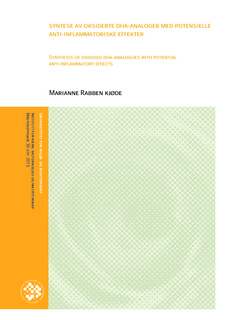| dc.description.abstract | SAMMENDRAG
Omega-3 og -6 fettsyrer har vist at de har viktige biologiske aktiviteter. De siste tiårene har
også deres derivater vist seg interessante, og de har gitt opphav til mange forbindelser som
bidrar positivt helsemessig og kan forebygge sykdommer som blodpropp, hjerteinfarkt, astma,
betennelser og lignede lidelser. Siden eikosapentaensyre (EPA) og dokosaheksaensyre (DHA)
har vist seg å være viktig for menneskers kosthold, ville det være interessant å se om noen av
deres derivater, (5E,7Z,10Z,13Z,16Z,19Z)-metyl-4-hydroksydokosa-5,7,10,13,16,19-
heksaenat og (5E,7Z,10Z,13Z,16Z,19Z)-metyl-4-oksodokosa-5,7,10,13,16,19-heksaenat, også
har noen interessante biologiske effekter.
Målet med oppgaven var å syntetisere to målmolekyler fra doksaheksaensyre (DHA),
(5E,7Z,10Z,13Z,16Z,19Z)-metyl-4-hydroksydokosa-5,7,10,13,16,19-heksaenat og
(5E,7Z,10Z,13Z,16Z,19Z)-metyl-4-oksodokosa-5,7,10,13,16,19-heksaenat. Dette ble gjort
med lineær syntese, der molekylene dihydro-5-((3Z,6Z,9Z,12Z,15Z)-1-
jodoktadekapentaenyl)furan-2(3H)-on og 5-((1E,3Z,6Z,9Z,12Z,15Z)-oktadeka-1,3,6,9,12,15-
heksaen-1-yl)dihydrofuran-2-(3H)-on ble brukt som intermediater for videre syntese.
Målmolekylene ble syntetisert som rasemater og i ren kjemisk form.
Det ble videre prøvd å utvikle en analysemetode med HPLC for å separere enantiomerene av
(5E,7Z,10Z,13Z,16Z,19Z)-metyl-4-hydroksydokosa-5,7,10,13,16,19-heksaenat, noe som ikke
ga baselinjeseparasjon, men ga lovende resultater. Den foreløpige metoden og den
fullstendige separasjonen av samme derivatet fra EPA, indikerer at det kan være mulig å få
total baselinjeseparasjon også for dokosaheksaensyre-derivatet.
Derivatene, fra reaksjonen mellom Moshers reagens med alkoholene nevnt over,
(5E,7Z,10Z,13Z,16Z,19Z)-metyl 4-(((R)-3,3,3-trifluoro-2-metoksy-2-
fenylpropanoyl))oksy)dokosa-5,7,10,13,16,19-heksaenat (R-MTPA ester) og
(5E,7Z,10Z,13Z,16Z,19Z)-metyl 4-(((S)-3,3,3-trifluoro-2-metoksy-2-
fenylpropanoyl))oksy)dokosa-5,7,10,13,16,19-heksaenat (S-MTPA ester) ble også syntetisert
for å se om det ville være lettere å separere diastereomerene med HPLC. Betingelsene som
ble utviklet for (5E,7Z,10Z,13Z,16Z,19Z)-metyl-4-hydroksydokosa-5,7,10,13,16,19-
heksaenat, kunne ikke brukes på disse Mosher-derivatene, og ingen metode ble utviklet.
! "#!
ABSTRACT
Both omega-3 and omega-6 fatty acids have shown that they have biological activities.
During the last decades their derivatives has also captured scientists interests, and they have
given rise to many compounds that contributes to better health and preventing many diseases
like asthma, coronary-, cardiovascular- and inflammatory diseases. Eicosapentaenoic acid
(EPA) and docosahexaenoic acid (DHA) are two of those fatty acids that have been shown to
be important for human health. It would therefore be interesting to see if some of their
derivatives, (5E,7Z,10Z,13Z,16Z,19Z)-methyl-4-hydroxydocosa-5,7,10,13,16,19-hexaenoate
and (5E,7Z,10Z,13Z,16Z,19Z)-methyl-4-oxodocosa-5,7,10,13,16,19-hexaenoate, also show
significance an activities.
The aim of this project was to synthesize two target molecules from docosahexaenoic acid
(DHA), (5E,7Z,10Z,13Z,16Z,19Z)-methyl-4-hydroxydocosa-5,7,10,13,16,19-hexaenoate and
(5E,7Z,10Z,13Z,16Z,19Z)-methyl-4-oxodocosa-5,7,10,13,16,19-hexaenoate. This was done
with linear synthesis, where the compounds dihydro-5-((3Z,6Z,9Z,12Z,15Z)-1-
iodoktadecapentaenyl)furan-2(3H)-one and 5-((1E,3Z,6Z,9Z,12Z,15Z)-octadeca-
1,3,6,9,12,15-hexaen-1-yl)dihydrofuran-2-(3H)-one were used as intermediates for further
synthesis. The target molecules were synthesized as racemates and with high chemical purity.
Furthermore an analytical method for separating the enantiomers of
(5E,7Z,10Z,13Z,16Z,19Z)-methyl-4-hydroxydocosa-5,7,10,13,16,19-hexaenoate was
developed. Although some separation could be seen, no baseline separation was achieved.
However, the method did work for the same derivative of EPA, indicating that it should be
possible to get total baseline-resolution for the docosahexanenoic acid-derivative, as well.
The derivatives, made from the reaction of Mosher’s reagent and the above mentioned
alcohols, (5E,7Z,10Z,13Z,16Z,19Z)-methyl 4-(((R)-3,3,3-trifluoro-2-metoxy-2-
phenylpropanoyl))oxy)docosa-5,7,10,13,16,19-hexaenoate (R-MTPA ester) and
(5E,7Z,10Z,13Z,16Z,19Z)-methyl 4-(((S)-3,3,3-trifluoro-2-metoxy-2-
phenylpropanoyl))oxy)docosa-5,7,10,13,16,19-hexaenoate (S-MTPA ester) were also
synthesized to see if their diastereomers would be easier to separate with HPLC. The
developed conditions for (5E,7Z,10Z,13Z,16Z,19Z)-methyl-4-hydroxydocosa!
#!
5,7,10,13,16,19-hexaenoate did not give any satisfactory results, so no method was
developed. | no_NO |
